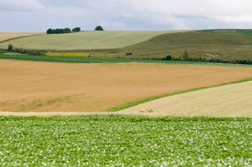Whole-Farm Revenue Protection Policy
 Whole-Farm Revenue Protection (WFRP) emerged from the 2014 Farm Bill as a new risk management option for diversified farms and those with historically limited access to crop insurance such as specialty and organic crop growers. Unlike traditional crop insurance policies that cover yield or revenue loss of a single crop, WFRP covers loss of revenue from multiple crops, animal, nursery, and resale products under one insurance policy. The United States Department of Agriculture-Risk Management Agency (USDA-RMA) recently announced some changes to WFRP for 2016 policies, but first here’s a general introduction to WFRP.
Whole-Farm Revenue Protection (WFRP) emerged from the 2014 Farm Bill as a new risk management option for diversified farms and those with historically limited access to crop insurance such as specialty and organic crop growers. Unlike traditional crop insurance policies that cover yield or revenue loss of a single crop, WFRP covers loss of revenue from multiple crops, animal, nursery, and resale products under one insurance policy. The United States Department of Agriculture-Risk Management Agency (USDA-RMA) recently announced some changes to WFRP for 2016 policies, but first here’s a general introduction to WFRP.
WFRP Basics
What farm revenue is covered?
The amount of farm revenue protected with WFRP is based on your “approved” farm revenue. This is the lower of the expected gross revenue for the insurance year OR your whole-farm historic average gross revenue, usually based on the 5 previous tax years. WFRP covers all commodities produced by the farm during the insurance year except timber, forest products, and animals for sport, show or pets.
What levels of coverage are available?
Growers can choose to protect 50% to 85% of their approved revenue, but at least 3 commodities must be produced to be eligible for the 80% and 85% coverage levels. Your commodity count, or diversification, also determines the premium rate discount and subsidy.
How much will the WFRP premium cost?
The premium cost for WFRP will be based on the farm county, the types of commodities produced, amount of revenue from each, and the commodity count. Farms with 2 or more commodities will receive a whole-farm subsidy resulting in less cost to the producer.
More Information on WFRP Basics.
WFRP Changes for 2016 Include:
Eligibility for Beginning Farmers and Ranchers (BFR) — BFR’s now qualify for WFRP with 3 years of farm tax forms and must earn farm revenue during their “lag year” prior to the insured year. BFR’s are also eligible for an additional 10% premium subsidy.
Use of a Different Person’s Tax Returns — Is accepted if one has inherited or is leasing at least 90% of the operation.
Modified Record Keeping Requirements — “Contemporaneous” records are now accepted records for direct marketers. “Contemporaneous” records can be developed at the time of commodity sale (e.g. at farmers market, roadside stand, etc.). Records must include the insured’s name, date, market name, total cash receipts, and listed names of commodities sold. For final production reporting, records must also include the estimated percentage of total cash receipts for each commodity sold and revenue per commodity received. Examples of Record Keeping Aids for Direct Marketing Producers are on the RMA WFRP webpage.
Increased Coverage for Livestock and Nursery Producers — Producers are now able to insure up to $1 million of expected revenue from animal/animal products and nursery/greenhouse products respectively.
Increased Coverage for Expanding Farm Operations — Farms physically expanding or increasing capacity are now able to increase their insurance guarantee by up to 35% of their average revenue history.
How Does WFRP Work for Organic Growers?
I’m an organic grower, how does this affect my eligibility for WFRP?
Those with an organic certificate from a certifying agent are eligible to receive an organic price for their commodities grown on organic acreage. Growers earning less than $5,000 with organic practices may use organic pricing with WFRP.
I run a CSA, sell at a farmers market and to a restaurant. I may be receiving 3 different prices for the same onions. How does this work?
Commodities with multiple expected values must be listed separately for reports and records. But for the commodity count, all onions, regardless of multiple market values will be counted once.
My operation is expanding. Can WFRP work for me?
An adjustment factor of up to 35% of your average revenue history can be applied if your operation is increasing existing production capacity or physically expanding.
Is contamination from application drift an insured cause of loss?
No, this is considered an uninsured cause of loss.
Is WFRP for You?
The efficacy of WFRP as a risk management tool depends on your ability to create and retain quality farm records. Are you able to keep sales records by crop and by market, as well as expense and inventory records? How well do you plan your farming year and adhere to the plan? Do your Schedule F’s reflect your actual whole-farm revenue? Beyond WFRP, a quality record keeping system will help you run a more profitable business, and position you well for loans and other programs.
More Information
The 2019 enrollment deadline for WFRP is March 15, 2019. Visit the RMA Website and the WFRP webpage. A list of agents serving Maine can be found using the RMA Agent Locator online or contact Crop Insurance Education Program Manager Erin Roche (erin.roche@maine.edu or 207.949.2490). If you’re unable to utilize WFRP, consider protecting your crops individually with crop specific policies or the Noninsured Disaster Assistance Program (NAP) through the Farm Service Agency.

